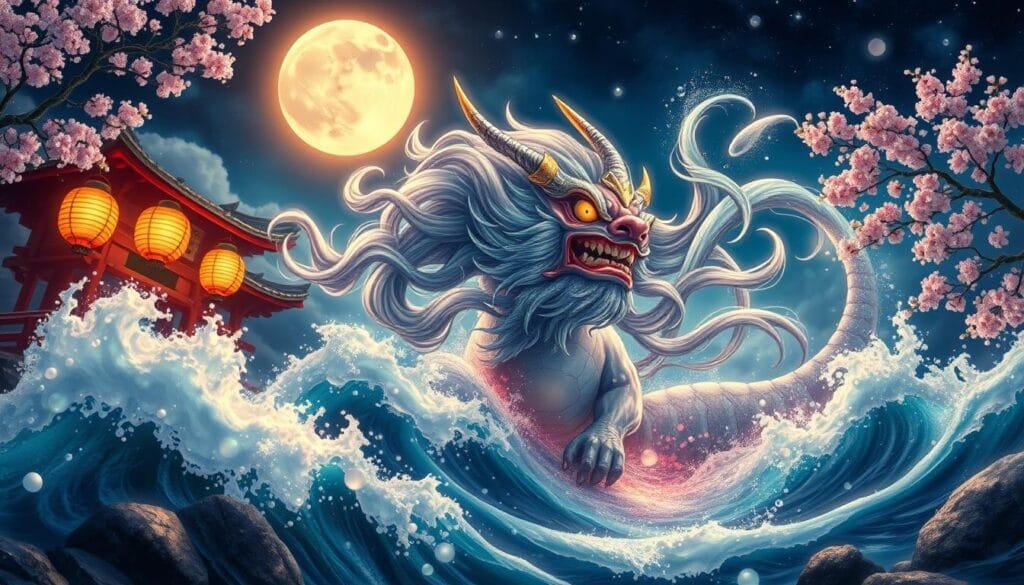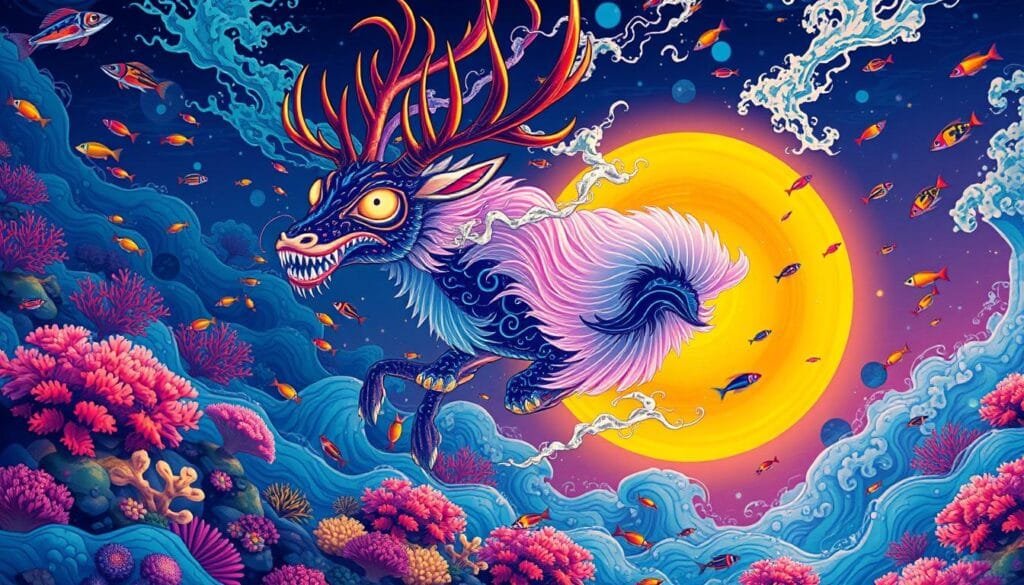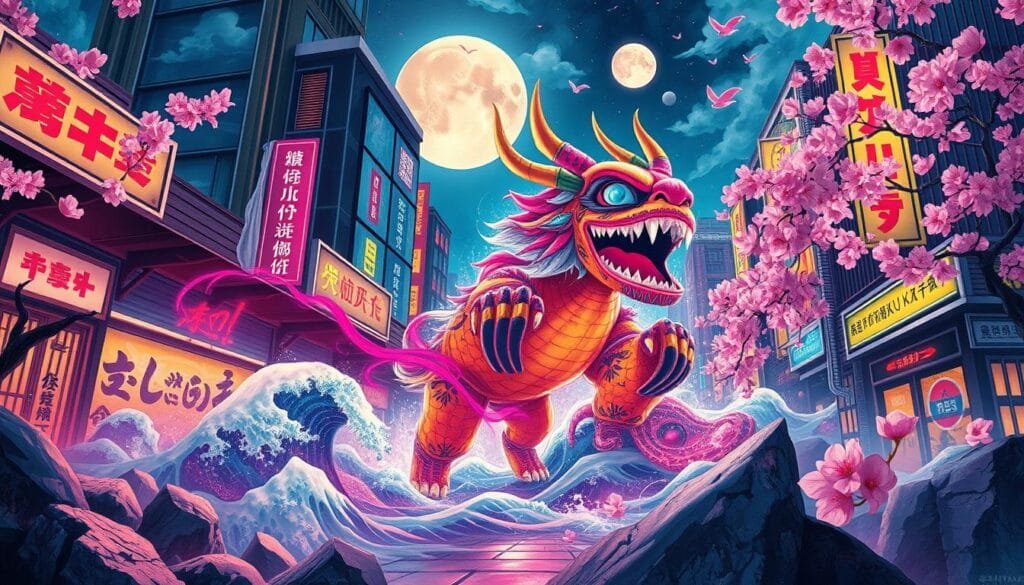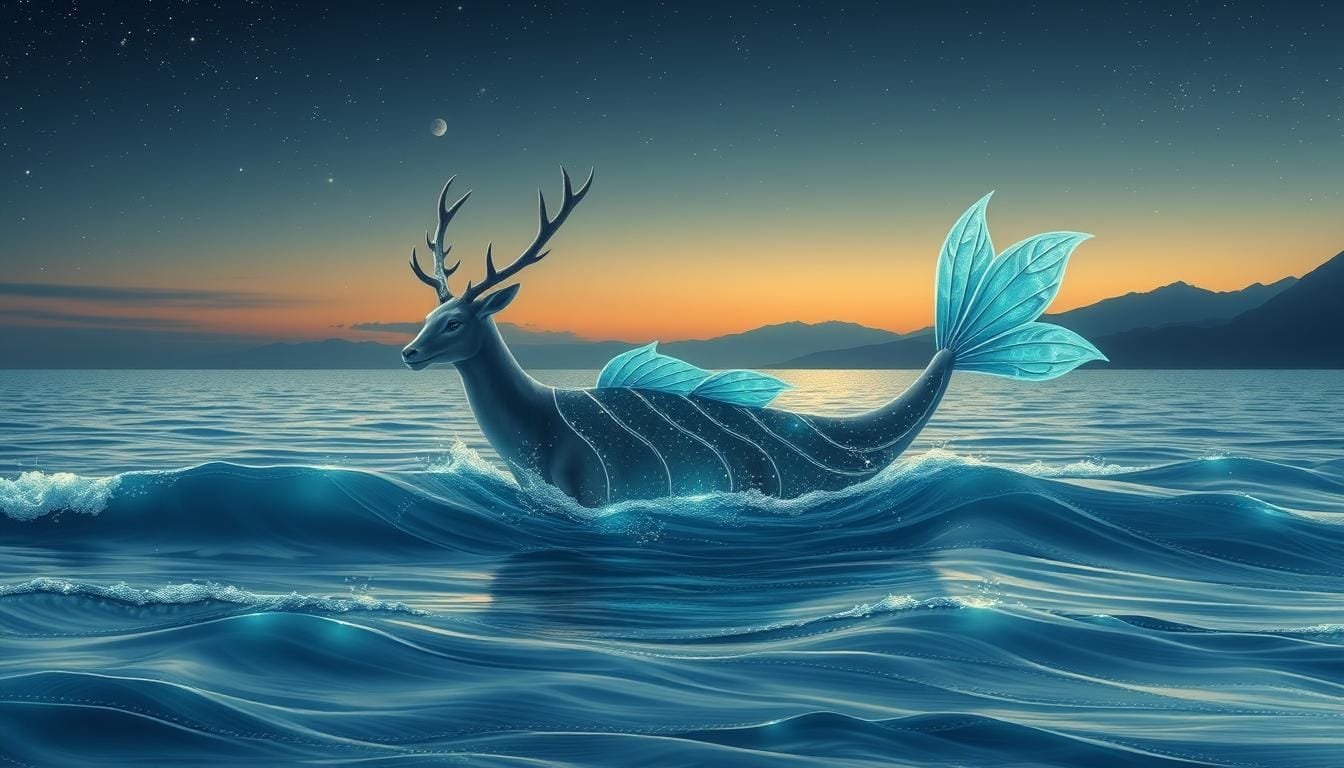Ever wondered about the Umishika Yokai from Japanese mythology? These creatures have moved from ancient stories to modern pop culture. They are now big in movies, books, and video games. This shows their strong impact on pop culture.
We’re diving into the world of Umishika Yokai. We’ll see how they’ve gone from Japanese myths to stars in entertainment. You’ll learn about where they come from, what makes them special, and how they’ve won over fans worldwide.
Key Takeaways
- Umishika Yokai are lesser-known mythological creatures from Japanese folklore.
- These folklore creatures have significantly impacted pop culture, making appearances in various entertainment formats.
- We will explore their mythological origins and how they compare to similar Yokai.
- From movies and literature to video games, Umishika Yokai have found a place in modern media.
- The Forbes Fictional 15 list highlights characters based on cultural impact, just as Umishika Yokai have.
Introduction to Umishika Yokai
Umishika Yokai are mythical creatures from Japanese folklore that capture the imagination. They have features of both land and sea animals. The Edo period (1603-1868) saw a rise in ghost stories and tales about these beings. Umishika Yokai have the upper body of a stag and the lower body of an eel. They also have sharp teeth and large antlers. Their unique characteristics add to the diversity of Japanese myths.
Origin and Characteristics
Umishika Yokai come from Japanese legends, combining folklore and mythology. They are related to the Perytons and both come from magical events. Umishika Yokai are known for being predators, which shows their importance in Japanese folklore. Their strong antlers and build help them survive on land and in water. Check out Umishika Yokai characteristics for more information.
Mythological Background
The story of Umishika Yokai is woven with various Japanese legends. In the Edo period, their tales became popular. They reflect Shintō, Buddhism, and influences from Chinese and Indian stories. Umishika Yokai are known for hunting near water, showing their cunning and strength. They are part of centuries of folklore in Japan.
Comparisons with Similar Yokai
Comparing Umishika Yokai to similar creatures is important. Like Perytons, Umishika have a mixed background. But, Umishika combine a stag’s strength with an eel’s agility. This shows the variety among Japanese myths and connects Umishika to other cultures’ creatures.
| Yokai Name | Origin | Physical Characteristics | Behavior |
|---|---|---|---|
| Umishika | Japanese folklore | Stag’s upper body, eel’s lower body, sharp teeth, antlers | Predatory, ambush at water’s edge |
| Perytons | Greek mythology | Stag’s body, bird-like features | Predatory, shadow mimicry |
Are Umishika Yokai in Any Pop Culture
Umishika Yokai are now part of various pop culture forms. They’re seen in movies, books, and video games. These mythical beings fascinate both creators and fans.
Appearances in Movies
In the movie world, Umishika Yokai have become popular. They bring a mix of mystery and fear to films. We see them in many stories, adding thrill and excitement.
These yokai are often in films about myths and legends. They help people learn more about mythical tales. The film industry has made these ancient stories more known and loved.

References in Literature
Books with Umishika Yokai have greatly impacted literature. Writers include them in stories, adding suspense and a touch of tradition. This keeps their significance alive in both old and new literature.
Many authors, from Lafcadio Hearn to today’s writers, explore these creatures. They make sure Umishika Yokai’s stories are passed down through time.
Representation in Video Games
Umishika Yokai video games are now more popular. Designers use them to make games more engaging and rich. Famous games like “Nioh” and “Okami” feature these yokai.
They’re more than just for looks in games. Their stories influence the gameplay and plot. This blend of folklore and gaming keeps the yokai alive for new fans.
Representation in Modern Media
The portrayal of Umishika Yokai has evolved significantly in the digital age, thanks to new media influence. Modern media has embraced these mythical creatures, showcasing their adaptability across various platforms.

Umishika Yokai media portrayal is seen in TV series and digital content. Shows like “Yokai Watch” and “GeGeGe no Kitaro” feature them. They mix traditional folklore with modern appeal.
Video games show the impact of new media on these myths. Games like “Ni no Kuni: Wrath of the White Witch” and “Yo-Kai Watch” use Umishika Yokai themes. They offer immersive experiences that deeply engage players.
Online platforms and social media also spotlight these creatures. Digital content creators often explore and reinterpret folklore themes there. This keeps the cultural depiction relevant and exciting.
Here is a comparative look at traditional versus modern media portrayal of yokai creatures:
| Aspect | Traditional Media | Modern Media |
|---|---|---|
| Medium | Folktales, Woodblock Prints | Television, Streaming Services, Video Games |
| Audience | Local Communities, Scholars | Global Audience, Gamers |
| Depiction | Static, Symbolic | Dynamic, Interactive |
| Narration Style | Mythological, Morality Tales | Entertaining, Engaging |
The ongoing Umishika Yokai media portrayal across varied mediums shows our enduring fascination. As digital platforms grow, so will the cultural depiction of yokai. It reflects both historical roots and modern innovations.
Umishika Yokai in Traditional Japanese Folklore
The Umishika Yokai hold a special place in Japanese folklore. To understand their significance, we must look into history, tales, and mythological roles. Our journey is grounded in detailed folklore studies and a review of ancient myths, focusing on the Umishika Yokai.
Historical References
The history of the Umishika Yokai stretches back to Japan’s ancient times. Historic texts mention these creatures, but their descriptions change over the years. Scrolls and paintings show the Umishika Yokai as powerful, similar to traditional stories.
Between the Heian and Edo periods, we see more about the Umishika Yokai in art and writing. How people saw them changed with society’s values. Scholars find the Umishika’s significance in these transitions. Documents from these times show their influence on views of the supernatural.
Role in Ancient Myths
In ancient myths, the Umishika Yokai played key roles. They are often seen as protectors and destroyers. They guarded natural spots and taught lessons about valuing nature.
Their stories also taught moral lessons. They showed bravery, wisdom, and respect for the mystical through human interactions. These lessons highlight the balance between humans and the supernatural. These tales remain important, affecting today’s view of yokai.
In summary, the Umishika significance is major in Japanese folklore. They feature in historical records and myths, showing a rich and complex image. This keeps folklorists and fans interested.
| Period | Depiction | Significance |
|---|---|---|
| Heian Period | Guardians with dual nature | Emphasis on respect for nature |
| Edo Period | Powerful supernatural beings | Reflected in socio-cultural beliefs |
| Modern Era | Symbolic figures in folklore | Continued cultural influence |
Influence on Contemporary Art
Contemporary artists cherish Yokai’s rich cultural background. They bring their visions to life in modern Yokai art. These mythical beings are seen in new ways through various creative forms.

Depictions by Modern Artists
The Edo period was a time of great cultural growth in Japan. Ghost stories and Yokai tales were very popular. They shaped the art of that time.
Today, artists like Takashi Murakami and Yoshitaka Amano find inspiration in these stories. They mix old tales with new styles to make meaningful art. Toriyama Sekien’s early works inspired many. They help new creatures come to life, keeping their cultural roots.
Inspiring New Creatures and Characters
Yokai stories continue to evolve. They inspire new characters in comics, TV, and games. Shigeru Mizuki’s work after World War II brought Yokai stories back. His manga, GeGeGe no Kitaro, led to fresh takes on Yokai.
This blend of old and new stories brings out new mythical creatures. They attract today’s audience.
Below is a table showing how Yokai have changed in media over time:
| Artist/Media | Era | Yokai Influence |
|---|---|---|
| Toriyama Sekien | Edo Period (1603-1868) | Formal recognition and categorization of Yokai |
| Shigeru Mizuki | Post-World War II | Reinvigoration of Yokai through manga |
| Takashi Murakami | Modern Era | Fusion of traditional and contemporary Yokai art |
| Yoshitaka Amano | Modern Era | Innovative Yokai-inspired character design |
Conclusion
We’ve explored the Umishika Yokai throughout this article. Their stories come from old myths, are part of today’s culture, and even influence modern art. The Umishika Yokai have a big effect on culture, showing how captivating these mythical creatures are.
We found interesting stories, like Uondo’s tale from 1791. It shows how Yokai stories changed for pop culture. Uondo’s journey mirrors larger cultural shifts, showing how history and innovation blend.
The future looks bright for Umishika Yokai in worldwide culture. They could appear in movies, books, or video games. These myths will keep inspiring people everywhere, keeping their mystery alive in our culture. As we keep studying the Umishika Yokai, their tales will surely enchant and inspire us all.
FAQ
What is an Umishika Yokai?
An Umishika Yokai is a mysterious beast from Japanese tales. It has a stag’s upper body and an eel’s lower body. Plus, it sports sharp teeth and antlers.
What are the key characteristics of Umishika Yokai?
This creature blends a stag’s torso with an eel’s tail. It has sharp teeth and large antlers. It’s known for being a predator in legends.
What is the mythological background of Umishika Yokai?
They’re said to be related to Perytons, born from magic gone wrong. Their stories are full of mystery and sightings in Japanese culture.
How does Umishika Yokai compare to similar Yokai like Perytons?
Umishika Yokai combines stag and eel features, while Perytons have deer and bird parts. Their differences show the wide variety in mythological creatures.
Are Umishika Yokai featured in any films?
Yes, they’ve appeared in films, highlighted for their hunting skills and mystery. Their movie roles have made them more popular.
How are Umishika Yokai represented in literature?
Writers include them in stories, exploring their myths, traits, and folklore roles. This enriches their cultural significance.
What role do Umishika Yokai play in video games?
In games, their unique looks and hunting traits make them standout characters. Gamers find them fascinating and exciting.
How are Umishika Yokai portrayed in modern media?
They’re shown in TV, online, and in games. Their evolving portrayal keeps them interesting today. They continue to captivate audiences.
What historical references mention Umishika Yokai?
They’re mentioned in old texts, art, and studies. These references highlight their importance in Japanese stories. They help us understand their folklore role better.
What roles did Umishika Yokai play in ancient Japanese myths?
They were symbols in old tales, teaching lessons or reflecting human concerns. They depict the depth of Japanese myths.
How have contemporary artists depicted Umishika Yokai?
Artists today reimagine them, blending modern styles with traditional tales. Their works keep these myths alive and inspiring.
In what ways have Umishika Yokai inspired new creatures and characters in modern media?
They’ve sparked new beings in media, showing how old myths can inspire new stories. They adapt to fit today’s culture and art.
